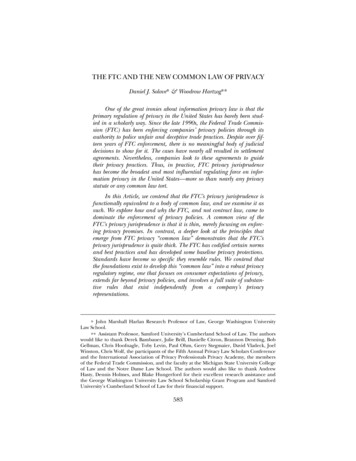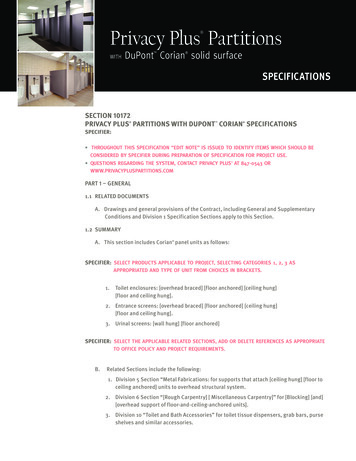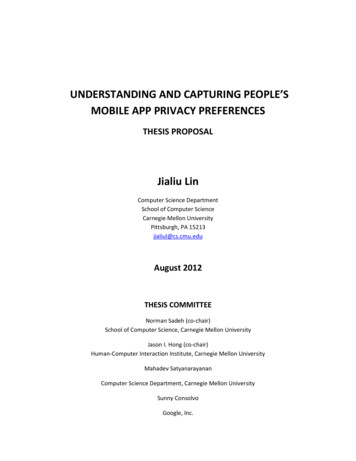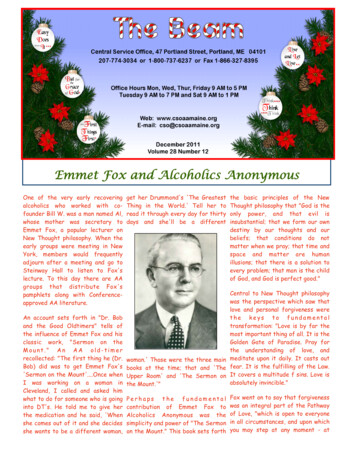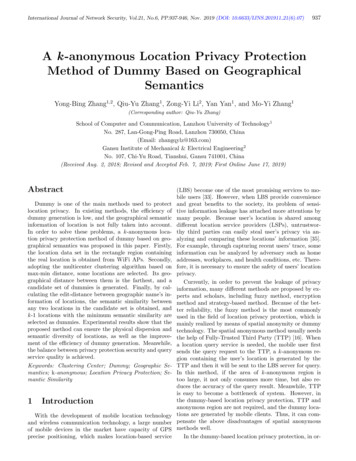
Transcription
International Journal of Network Security, Vol.21, No.6, PP.937-946, Nov. 2019 (DOI: 10.6633/IJNS.201911 21(6).07)937A k -anonymous Location Privacy ProtectionMethod of Dummy Based on GeographicalSemanticsYong-Bing Zhang1,2 , Qiu-Yu Zhang1 , Zong-Yi Li2 , Yan Yan1 , and Mo-Yi Zhang1(Corresponding author: Qiu-Yu Zhang)School of Computer and Communication, Lanzhou University of Technology1No. 287, Lan-Gong-Ping Road, Lanzhou 730050, China(Email: zhangqylz@163.com)Gansu Institute of Mechanical & Electrical Engineering2No. 107, Chi-Yu Road, Tianshui, Gansu 741001, China(Received Aug. 2, 2018; Revised and Accepted Feb. 7, 2019; First Online June 17, 2019)AbstractDummy is one of the main methods used to protectlocation privacy. In existing methods, the efficiency ofdummy generation is low, and the geographical semanticinformation of location is not fully taken into account.In order to solve these problems, a k -anonymous location privacy protection method of dummy based on geographical semantics was proposed in this paper. Firstly,the location data set in the rectangle region containingthe real location is obtained from WiFi APs. Secondly,adopting the multicenter clustering algorithm based onmax-min distance, some locations are selected. Its geographical distance between them is the farthest, and acandidate set of dummies is generated. Finally, by calculating the edit-distance between geographic name’s information of locations, the semantic similarity betweenany two locations in the candidate set is obtained, andk -1 locations with the minimum semantic similarity areselected as dummies. Experimental results show that theproposed method can ensure the physical dispersion andsemantic diversity of locations, as well as the improvement of the efficiency of dummy generation. Meanwhile,the balance between privacy protection security and queryservice quality is achieved.Keywords: Clustering Center; Dummy; Geographic Semantics; k-anonymous; Location Privacy Protection; Semantic Similarity1IntroductionWith the development of mobile location technologyand wireless communication technology, a large numberof mobile devices in the market have capacity of GPSprecise positioning, which makes location-based service(LBS) become one of the most promising services to mobile users [33]. However, when LBS provide convenienceand great benefits to the society, its problem of sensitive information leakage has attached more attentions bymany people. Because user’s location is shared amongdifferent location service providers (LSPs), untrustworthy third parties can easily steal user’s privacy via analyzing and comparing these locations’ information [35].For example, through capturing recent users’ trace, someinformation can be analyzed by adversary such as homeaddresses, workplaces, and health conditions, etc. Therefore, it is necessary to ensure the safety of users’ locationprivacy.Currently, in order to prevent the leakage of privacyinformation, many different methods are proposed by experts and scholars, including fuzzy method, encryptionmethod and strategy-based method. Because of the better reliability, the fuzzy method is the most commonlyused in the field of location privacy protection, which ismainly realized by means of spatial anonymity or dummytechnology. The spatial anonymous method usually needsthe help of Fully-Trusted Third Party (TTP) [16]. Whena location query service is needed, the mobile user firstsends the query request to the TTP, a k -anonymous region containing the user’s location is generated by theTTP and then it will be sent to the LBS server for query.In this method, if the area of k -anonymous region istoo large, it not only consumes more time, but also reduces the accuracy of the query result. Meanwhile, TTPis easy to become a bottleneck of system. However, inthe dummy-based location privacy protection, TTP andanonymous region are not required, and the dummy locations are generated by mobile clients. Thus, it can compensate the above disadvantages of spatial anonymousmethods well.In the dummy-based location privacy protection, in or-
International Journal of Network Security, Vol.21, No.6, PP.937-946, Nov. 2019 (DOI: 10.6633/IJNS.201911 21(6).07)der to improve the efficiency of dummy location generation and the query service quality, a k -anonymous location privacy protection method of dummy based on geographical semantics was proposed. In this paper, wegive full consideration to the geographical semantic information features of locations. Firstly, adopting multicenter clustering algorithm based on max-min distance(MCAMD) [24], a number of cluster centers are generated by clustering calculation, which constitute a candidate set of dummies. Then, using edit-distance [37] tocalculate semantic similarity of geographic name’s information among elements in candidate set, and k -1 locations with the minimum semantic similarity are selectedas dummies. The proposed method can meet semanticl -diversity and physical dispersion of locations, and improve the efficiency of dummies generation. Furthermore,it improves the query service quality.Our main contributions can be summarized as follows:1) A dummy selection method considering the geographical semantic information characteristics of locations is proposed, which balanced the contradictionbetween privacy protection and query quality.2) A multi-center clustering algorithm based on themax-min distance method is used to generate candidate set of dummies, which can ensure the physicaldispersion of the dummies.3) We calculate the semantic similarity between geographic name’s information of locations, and the locations with the smallest semantic similarity is selected as the dummies, which ensures the semanticdiversity of the dummies.The remaining part of this paper is organized as follows.Section 2 reviews related work of location privacy protection. Section 3 gives system model of this paper. Section 4 describes two algorithms and analysis. Section 5gives the experimental results and performance analysisas compared with other related methods. Finally, we conclude our paper in Section 6.2Related WorkThe location privacy protection method is divided intotwo main categories according to the system architecture, including distributed structure [21]based on Peerto-Peer (P2P) [23]and central server structure based onTTP [29]. In the distributed structure, location privacy protection is accomplished through collaboration between users. Chow et al. [4, 6, 7] proposed a P2P-basedspatial anonymity method. In these methods, the k anonymous privacy protection based on distributed architecture is achieved by using location information ofneighbors’ node, but the security of the neighbors’ nodeis ignored. The P2P-based scheme is simple and flexible, but which greatly increases various overhead of thesmart phone. Furthermore, users are mobile rather than938static [34]. In a centralized structure based on TTP, amethod of location privacy protection based on TTP isproposed by Zhou et al. [36]. This structure mode hasgood effect of privacy protection, but TTP also needs tobe protected. Li et al. [12] proposed a location privacyprotection scheme based on efficient information cache,which reduces the number of times that the users’ accessto TTP, the query efficiency is improved, and the probability of information leakage is reduced, but the burdenof the mobile client is increased.In addition, Cheng et al. [3] put forward an independent structure model, and users protect location privacyaccording to their own abilities and knowledge. The structure of this method is simple, which is easy to merge withother structures, but it requires high performance for mobile clients. Li et al. [11] put forward a multi-server architecture, users can be divided into different subsets according to the security requirements, and each location servercan only obtain partial subset. The concealment of location is improved in this method, but it is mainly suitablefor the social network. Mouratidis et al. [15] put forwarda location privacy protection method based on privacyinformation retrieval, and its location privacy protectionis implemented by using retrieval and encryption. Thelocation privacy is well protected in this method, but itincreases the overhead of communication and hardware,and reduces the query service quality. With the maturity and popularity of cloud service technology, Kim etal. [10] proposed a location privacy protection methodbased on searchable encryption. By accessing to the cloudserver in the encrypted state, the security of location dataand query records is guaranteed, but query efficiency andquery accuracy need to be improved further.In the recent researches, k -anonymity [25] is still themainstream method of location privacy protection, whichwas born in the relational database, and its key attributeis dealt with using generalization and fuzzy technology.So none of the records can be distinguished from other k 1 records, and the location anonymity is realized. Themethod of k -anonymity location privacy protection ismainly divided into spatial region anonymity and dummyanonymity. Gruteser et al. [5] proposed a k-anonymitylocation privacy protection method, and its location privacy is protected by constructing k -anonymous region.The region must meet two conditions: 1) The area of theregion reaches a certain value; 2) There are k users in theregion. Due to the above tow limitations, the effect of location privacy protection is improved, but all users musthave the same location anonymity requirement. Bamba etal. [1] put forward a method of grid partition, which provide two algorithms: Top-Down Grid Cloaking algorithmand Bottom-Up Grid algorithm, which can be selected according to the users’ needs. Xu et al. [27] proved that thesize of k -anonymous region has a great impact on the accuracy of query results, which provides guidance for theresearch of anonymous region partition. On this basis,some anonymous region construction methods with various geometric shapes were presented in [20, 26, 30, 31].
International Journal of Network Security, Vol.21, No.6, PP.937-946, Nov. 2019 (DOI: 10.6633/IJNS.201911 21(6).07)However, these methods have two serious shortcomings:First, it must rely on TTP, but TTP is not absolutely secure, and it’s easy to become the bottleneck of the system.Second, the size of anonymous region and the accuracy ofquery results are a pair of contradiction, and the largerthe anonymous region, the better the effect of privacyprotection, but the accuracy of the query results will bereduced.Because of these above serious shortcomings in thespatial anonymity method, the k -anonymity method ofdummy has been widely used. The dummy method wasfirst introduced into the location privacy protection byKido et al. [8, 9] in 2005. And then Lu et al. [14] proposed a method of randomly adding dummy locations ina circular or rectangular region, users can select dummylocations in the region according to their demands. Several dummy-based privacy protection methods for continuous queries in mobile trajectories were proposed in document [13,28,32]. Niu et al. [18] took into account the adversaries’ attack with background information, and DLSalgorithm and improved DLS algorithm were proposed.Then, Niu et al. [19] introduced cache mechanism intothe location privacy protection, a cache-based dummy selection algorithm (CaDSA) was proposed, which has improved the query efficiency. Next, Niu et al. [17] proposed a mobile location privacy protection scheme namedDUMMY-T, which aims to protect user’s location privacy from background attacks, the dummy is generatedby the dummy location generation (DLG) algorithm, anddummy path is generated by the dummy path construction (DPC) algorithm, which ensure the security of location privacy. Sun et al. [22] selected dummy locations byprobability estimation, which can prevent probability attack, and solve the problem that attackers can judge thereal location information by analyzing historical records.33.1System ModelAttack ModelIn location-based services, common attacks includebackground attack, probability attack and semantic attack. For background attacks, location privacy is usuallyprotected by eliminating the link between background information and the user’s current location. In general, inorder to overcome the probability attack, after obtainingthe history query record of the query user, the locationswith high query probability is used as the dummies toconfuse the attacker. However, there are many forms ofsemantic attack, so the difficulty of protection is large.In existing study, most methods select dummy according to query probability, which seldom consider the location’s geographical semantic information, and adversaries can easily obtain user’ location by analyzing thegeographical semantic information. As shown in Figure 1,solid triangle A represents real position, Hollow circle represents dummy candidate set, and solid circle B and Crepresent the selected dummy locations.(a)939(b)Figure 1: A sample of the location similarity attack: (a)Semantic features; (b) Geographical featuresAs shown in Figure 1(a), A, B and C are the selecteddummy locations, assuming that the three locations are inthe hospital, and adversaries can easily identify that usershave health problems through semantic analysis. The selected dummies are too close to the real location in Figure1(b), adversaries can easily find the exact location of theuser by computing geographical distance. Therefore, theselection of dummies should consider the geographical semantic information of the location as much as possible,which can ensure the physical dispersion and semanticdiversity of all locations including the real location, andfurther improve the effect of location privacy protection.In order to prevent location privacy leakage due to geographical semantic attacks, Chen et al. [2] proposed adummy selection method based on semantic-aware. Thephysical dispersion and semantic diversity of dummies areguaranteed. However, this method needs to repeatedlycalculate the physical distance and semantic distance between all locations, and the efficiency is relatively lowwhen location data is large. Furthermore, it needs construct semantic tree for locations in WiFi APs to computethe semantic distance, the burden of WiFi APs and thetime of preprocessing is increased, and the service qualityis reduced.3.2System StructureIn the TTP-based central server model, if users initiate more queries, TTP is easy to become a system bottleneck. Furthermore, TTP is not absolutely safe andreliable. Once TTP is attacked, all locations privacy willbe leaked. So, we use a system model without TTP inthis paper, and the generation of dummies and the sending of query requests are all accomplished by the mobileclient. The system structure model is shown in Figure 2.In this system structure, the mobile user obtains thelocation information of the region including the real location from WiFi APs, as shown in Figure 3 and Figure 4.Firstly, by adopting the MCAMD algorithm, a number ofcluster centers are generated in mobile client. These locations are the farthest from each other, the dummy can-
International Journal of Network Security, Vol.21, No.6, PP.937-946, Nov. 2019 (DOI: 10.6633/IJNS.201911 21(6).07)940{l1 , l2 , · · · , lk 1 } represents the dummy set that satisfiessemantic diversity. Let lreal represents the user’s location,and the location result set includes the dummy set S2 andreal location lreal .Definition 4. If the semantic similarity between li and lj SEM satisfies the following conditions: 1 C 2 ti θ, wherekFigure 2: System structure modelSEMti {lsem lsem (li , lj ) l}, k RSti , Ck2 is a combination formulas, l is the default threshold of the semanticdiversity. Then, the result set RSti is called a θ-securitydidate set is generated from them. Then, the semantic set, and the purpose of privacy protection is to get thesimilarity is calculated for the location information of the maximum value of θ by 1, the semantic similarity betweencandidate set, and the k -1 locations with the minimum li and lj is equal or less than 0.2.semantic similarity are selected as the dummies. Finally,the mobile user sends k -1 dummies and real location to4 Algorithmic Descriptionthe LBS server to query.The proposed method of dummy generation is implemented by the following two algorithms: The dummy candidate set S1 is generated through cluster calculation inAlgorithm 1. In Algorithm 2, the dummy set S2 is generated by calculating semantic similarity of locations in thecandidate set S1 .4.1Algorithm 1Algorithm 1: Calculating physical distance and obtaining dummy locations set.Figure 3: Selected location regionInput: Location data set Sn , demand parameter m.Output: Generate a dummy candidate set S1 .Step 1: Given γ value, 0 γ 1.Step 2: The real location lreal is taken as the first clustercenter Z1 .Step 3: Find the location that it is the farthest locationfrom Z1 , which is treated as a second Cluster centerZ2 .Figure 4: Geographical location in the regionStep 4: For each li of the remaining objects in Sn , itsdistance to Z1 and Z2 is Di1 and Di2 . Assumedthat D12 is the distance between Z1 and Z2 , if Di max{min(Di1 , Di2 )}(i 1, 2, · · · , n) and Di γ ·D12 , then take li as the third Cluster center Z3 .Step 5: And so on, get all the v clustering centers thatconforms to the conditions. When max-min distance3.3 Definitionis lower than γ · D12 , the calculation for finding theclustercenter is finished.Definition 1. Let Rs represents the selected rectangulararea, and Sn {l1 , l2 , · · · , ln } represents the set of loca- Step 6: Suppose v represents the number of cluster centions in the rectangle region.ters obtained by calculation, judge:Definition 2. Let lphi represents the physical distancebetween any two locations, and lsem represents the set oflocations in the rectangle region.1) If v m, the algorithm is over, then Step 7,2) If v m, re-select the γ value, and turn to Step1.Definition 3. Let S1 {l1 , l2 , · · · , lm } represents thecandidate set that satisfies physical dispersion, and S2 Step 7: The dummy candidate set S1 is generated.
International Journal of Network Security, Vol.21, No.6, PP.937-946, Nov. 2019 (DOI: 10.6633/IJNS.201911 21(6).07)4.2941Algorithm 2and then l5 is selected as second cluster center, and thenthird cluster center l9 is determined. After clustering calAlgorithm 2: Calculating semantic similarity and obculation, three clustering centers are obtained, and thetaining dummy location result set.dummy location candidate set is generated.Input: Location candidate set S1 , semantic diversity parameter threshold l.Output: Location result set S2 .Step 1: Matching each character of the place name information in turn, and ignore the same prefix characterswith the same matching values. Then, get two newcharacter strings A and B.Step 2: Suppose that the string A contains i characters and it is represented as A a1 a2 a3 Lai ; the stringB contains j characters and it is represented asB b1 b2 b3 Lbj .Figure 5: Example of MCAMDA algorithmStep 3: A dynamic programming matrix of i 1 columnsWhen determining the cluster center, the real locationand j 1 rows is constructed. The last element obisusedas the initial cluster center Z1 . If li is selected astained from D[i, j ] is ed (A,B ).the i -th clustering center, the conditions must be satisfied.Step 4: If j 0, return i and then exit; if i 0, return jDi γ · D12 (i 1, 2, · · · , n)(1)and then exit.where Di max{min(Di1 , Di2 )}(i 1, 2, · · · , n) , D12 Step 5: The first row is initialized to 0,1,L,i ; the first Z2 Z1 , γ is the test parameter in the algorithm, it’scolumn is initialized to 0,1,L,j.usual value is 0.5 γ 1.Step 6: Assign values for each element in the matrix: ifai bi , then D[i, j ] D[i -1, j -1]; if ai 6 bi , then D[i, 4.4 Algorithm 2 Descriptionj ] 1 min(D[i -1, j -1], D[i -1, j ], D[i, j -1]).Algorithm 2 computes semantic similarity for locationStep 7: Repeat step 6, until all the values in the matrix information of dummy candidate set. Firstly, according to the characteristics of Chinese geographical names,are obtained, the final edit-distance is D[i, j ].the same prefix in place name information is eliminated.Step 8: Calculating similarity matching index S (A, B ) Then, by calculating semantic similarity for the remainthrough D[i, j ], that is Semantic similarity.ing string of place name through the edit-distance, theefficiency and the accuracy of calculation is improved.Step 9: Select the k -1 locations with the minimum seFor example, “Guangzhou second middle school” andmantic similarity, and dummy result set S2 is gener“Guangzhou Tie Yi middle school” are two strings of Chiated.nese place name. The characters of “Guangzhou” do nothave any meaning for the calculation of semantic similar4.3 Algorithm 1 Descriptionity in the two place name strings, and which also affectUsing the MCAMD algorithm to compute cluster cen- the accuracy of the calculation results. So “Guangzhou”ter for location geographic coordinates in a square region, is eliminated as a prefix in the calculation.D[i, j ] is the edit-distance of the dynamic programmingseveral cluster centers are obtained, which are selectedmatrix,and the cost of the each edit operation is betweenas dummy candidate set. The MCAMD algorithm is a0and1.And it can be set different values according toclustering algorithm based on heuristic, which takes astherequirements.In this paper, the value is set to 0 orfar away objects as cluster centers according to Euclidean1.ifa b,thecost of replacement is 0. Otherwise,iidistance. Firstly, a sample object is used as the first clusthecostofalleditoperations is 1. In Equation (2), Dter center, and then a sample which is the farthest fromisadynamicprogrammingmatrix, which represents thethe first cluster center is selected as the second clusteredit-distancebetweenstringA “Second middle school”center. Then determine the other cluster centers, untilandstringB “TieYimiddleschool”.there is not new cluster center. After determining all theclustering centers, the clustering sample set including msamples is taken as dummy location candidate set.The example of cluster center calculation is shown inFigure 5, there are ten locations in the region. According to Algorithm 1, l1 is selected as first cluster center,D 0123411234222343332344432(2)
International Journal of Network Security, Vol.21, No.6, PP.937-946, Nov. 2019 (DOI: 10.6633/IJNS.201911 21(6).07)942The edit-distance between the two strings is obtained 5.1 Average Execution Timeby calculating, which is D[i, j ] D[4, 4] 2. Using EquaFirstly, the efficiency of the proposed method is vertion (3) to calculate the similarity matching index beified through experiment. In dummy location selectiontween the strings, that is semantic similarity. The semanmethod considering semantic similarity, we compare thetic similarity is 0.5.average execution time of dummy locations with MaxD[i, j](3) MinDistDS [2], SimpMaxMinDistDS [2] and the proposedS(A, B) 1 max{ A , B }method. The average execution time of dummy locationsWhere A and B represents the length of two strings of the three methods is shown in Table 2.In Figure 6, we compare the efficiency of generatingrespectively, and the maximum length of string S is useddummieswith MaxMinDistDS, SimpMaxMinDistDS andto calculate semantic similarity.theproposedmethod. As the Figure 6(a) shown, withAt last, according to the Equation (4), the k locationstheincreaseofk, the MaxMinDistDS algorithm takeswith the minimum semantic similarity including the realmuchmoretimethan the proposed method. As the Figlocation are obtained.ure 6(b) shown, when k 5, the average execution timeArg min(S(li , lj ))(4) of SimpMaxMinDistDS algorithm is slightly larger thanthat of the proposed method, when k 5, the average executiontime of SimpMaxMinDistDS algorithm is much4.5 Algorithm Analysislarger than that of the proposed method. As can be seenIn this paper, firstly, adopting the MCAMD Algorithm, from Figure 6, with the increase of k, the efficiency of theto select the m(m 2k) locations with the maximum proposed method is more and more advantageous thandistance from each other as dummies, dummy candidate the other two algorithms.set including the real location is generated. Then, bycalculating the semantic similarity of the locations in thecandidate set, the k locations including the real locationare selected as the result set. So physical dispersion andsemantic diversity of k locations are ensured.In Algorithm 1, the candidate set of dummies is generated by clustering calculation, and the physical dispersionbetween different locations is guaranteed. The clusteringresults of the algorithm are related to the selection of parameter γ and the first cluster center Z1 , and the reallocation is used as the initial cluster center. To makesure that the numbers of samples in the candidate set isenough, the number of cluster centers m satisfy the condition of m 2k. In this paper, the initial parameter value(a)of γ is 0.5.In Algorithm 2, the semantic similarity of geographicname’s information is obtained by calculating the editdistance. In the calculation, the more similar the character in the two strings are, the smaller the edit-distanceis, while the greater the semantic similarity is. When thetwo strings are exactly the same, the edit-distance is 0,and the semantic similarity is 1.5Experimental Results and Analysis(b)In order to evaluate the performance of the proposedmethod, we use a real map of Guangzhou from Googlemaps, and select the 55 WiFi APs in the 8km 8km. Thehardware environment of the experiment is as follows:3.2 GHz Intel Core i5 processor with memory size of 4GB. The operating system is Windows 7. The proposedmethod is implemented by Eclipse development platformand Java programming language.Table 1 is configured for the default parameters of theexperiment.Figure 6: Average generation time of dummy: (a) Comparison between MaxMinDistDS and the proposed; (b)Comparison between SimpMaxMinDistDS and the proposedIn addition, we compare the efficiency of generatingdummies with Random [9], Rotation [32], Footprint [28]and DUMMY-T [17] algorithm, as shown in Figure 7.As can be seen from Figure 7, with the increase of k,
International Journal of Network Security, Vol.21, No.6, PP.937-946, Nov. 2019 (DOI: 10.6633/IJNS.201911 21(6).07)943Table 1: Experimental default parameter configurationParameterklγLocation setSpace range (km2 )WiFi APs Coverage range(m)Value[2, 16] 0.216km 16km100008 8800Table 2: Average execution time vs. 22s8899.45s0.22s0.026sComparison of Physical DispersionIn this paper, we compare the minimum distance ofdummies with SimpMaxMinDistDS, MaxMinDistDS andthe proposed method. The result is shown in Figure 8.Figure 7: Average generation time of dummythe average execution time of these algorithms is all increasing. Among them, the average execution time of theproposed and Random algorithm is smaller than otherthree algorithms. The average execution time of Random algorithm is the least, and the average executiontime of the Rotation algorithm is the most. As the Figure 7 shown, when k 4, the average execution time ofFootprint, DUMMY-T and the proposed method are thesame. When k 4, The difference in the execution time ofthe five algorithms is getting bigger and bigger. With theincrease of k, average dummy generation time of the proposed method is larger than that of Random algorithm,but it is smaller than the other three algorithms.Through the analysis of efficiency comparison experiments, it is found that the efficiency of the proposedmethod is higher than the other three algorithms except Random algorithm. The Random algorithm is randomization, and the effect of privacy protection is relatively poor. The experimental results show that, whenthe anonymity is large, the proposed method is more efficient under the condition of maintaining good locationprivacy. Therefore, the efficiency of dummy generation isfurther improved. And the larger the k is, the better theeffect is.Figure 8: The minimum distance vs. kAs can be seen from Figure 8, the minimum distancebetween dummies of several methods is mostly reducedwith the increase of k, but the minimum distance ofthe proposed method is obviously larger than the MaxMinDistDS and SimpMaxMinDistDS. Because the proposed method uses the clustering center algorithm in Algorithm 1, and selects the dummies with relatively largedistance as the dummy location set, which gives priorityto ensuring physical dispersion between locations. However, the MaxMinDistDS first satisfies the semantic diversity and then guarantees the physical dispersion, andthe SimpMaxMinDistDS selects the larger in the physicaldistance and the semantic distance as the dummy location result set. From the experimental result we can seethat the proposed method has better physical dispersion.
International Journal of Network Security, Vol.21, No.6, PP.937-946, Nov. 2019 (DOI: 10.6633/IJNS.201911 21(6).07)5.3Comparison of Semantic DiversityWe compare the semantic diversity with the proposed method, MaxMinDistDS, SimpMaxMinDistDS andDLS [18] through experiment. According to the semanticdiversity of the locations in the dummies result set, theθ-secure is obtained, as shown in Figure 9.Figure 9: θ-secure vs. kAs can be seen from Figure 9, with the increase ofk value, the θ value of algorithm MaxMinDistDS andSimpMaxMinDistDS basically do not change, and alwaysreach 1. The θ value of the proposed method is alwaysthe maximum value 1, which can satisfy the requirementof semantic l -diversity. The θ value
ographical semantics was proposed. In this paper, we give full consideration to the geographical semantic in-formation features of locations. Firstly, adopting multi-center clustering algorithm based on max-min distance (MCAMD) [24], a number of cluster centers are gener-ated by clustering calculation, which
